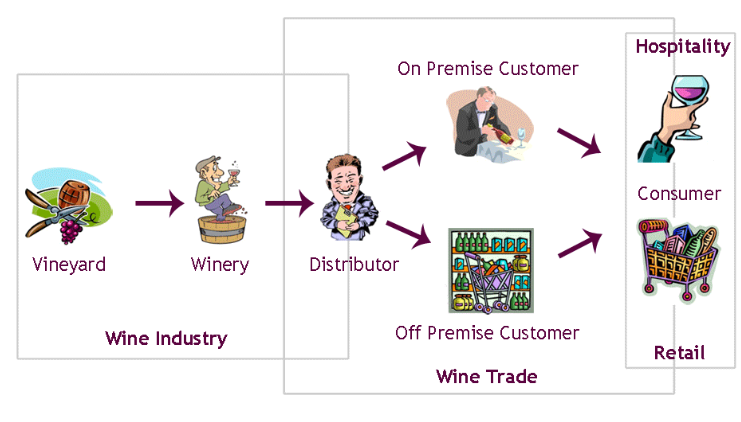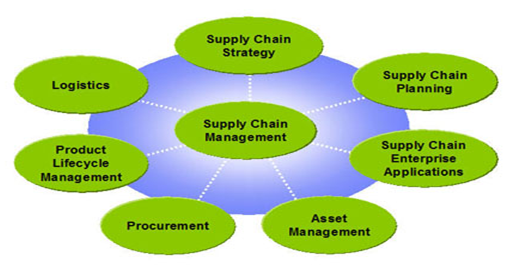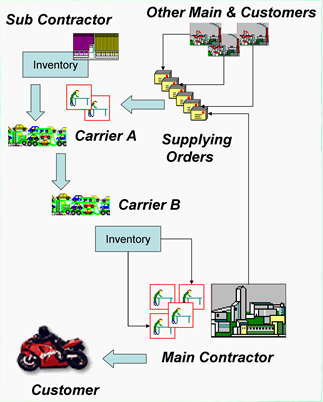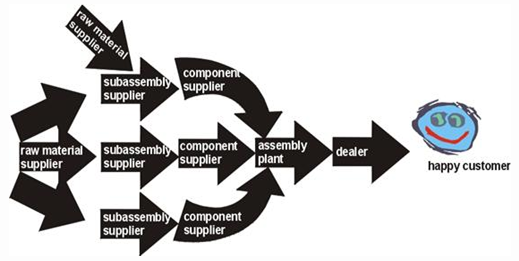Supply Chain Requirements From Source to Consumer, Research Paper Example
Introduction
This paper examines the supply chain requirements from source to the end consumer. The case study is based upon the production of Robert Mondavi Chardonnay wine in California. Mondavi is a celebrated wine producer based in the Napa Valley in California. They produce an excellent Chardonnay wine that is noted for its’ aromas of Pear and Quince with delicate floral notes that echo the distinctiveness of Chardonnay from this region. The wine is matured in French Oak barrels and like many other wines from this region has won numerous awards.
A supply chain may be defined as the number of business practices that move goods from that of raw materials through supply, production and the final distribution of the goods to the customer. Most manufacturing organizations have a supply chain of some description. It is considered that all effective management practices must take into consideration the efficiencies of the component within the chain in order to avoid loss of quality and important customers within the business.
The Process
Within any supply chain there are five key elements: 1) Production 2) Supply 3) Inventory 4) Location and 5) Transportation and Information. Each of these are examined in turn.
Production
In order to facilitate strategic decision making relative to production it is important to understand both what the client wants and equally what the market demands. This leads to the development of supply chain agility and indicates how many products will need to be completed; the sequence to be completed, the individual components required and which plants are capable of producing them. Each of these decisions needs to focus on items such as inventory management, quality, capacity and the volume of goods to be produced in order to meet the customer need. In addition what techniques of quality control need to be introduced in order to meet the required standards of production.
Supply
This relates to the facility being able to produce efficient and economical goods whilst maintaining high levels of quality. This can be very hard for companies to achieve, particularly when the product incorporates external sub components made outside of the firm. Hence there is a need to QA external products as meeting a required standard of quality. This not only applies to imported finished goods but also the quality of raw materials being used. When selecting a supplier it is a careful balance of cost, quality, reliability and flexibility. A good supplier relationship helps to build a strategic business relationship.
Inventory
Other important decisions relate to stock or inventory and as such it is a very fine balance between holding too much inventory and not enough. This becomes an important aspect of supply chain management and it is important to retain optimum levels of stock at different locations without holding too much inventory which creates under-utilized capital. There is also the risk of obsolescence for those goods that exceed their storage dates. Control policies need to examine the procedure for retention of inventory and this involves close customer relationship management.
Location
Strategic decisions are focused upon such items as the location of production plants, distribution and stock facilities and the location of these facilities to the market. Once customers are established it is important that they are services by having production facilities within close proximity to them. This was an important part of the success of the Industrial Revolution in Britain the mines producing raw materials i.e. Coal, Coke etc. were close to the factories that needed to burn them for power and fuel, together with the steel plants that needed the coal for the furnaces.
Mondavi in Context

Mondavi harvests a variety of grape sources that go to make 100% Chardonnay. This consists of 47% Cameros, 37% South Nappa, 12% Sonoma County and 4% Other Napa varieties. The grapes are harvested in early morning and then pressed to produce the wine juice. This is then allowed to ferment in Oak barrels with a certain supply that is aged in Steel wine tanks for maturity before going to the bottling process.
The wine undergoes regular stirring and ageing for around 8 months. The Oak barrels are supplied from French Coopers who provide the right Oaks and weight for the barrels.

The Supply Chain for wine production is illustrated in the diagram above. The process starts off with the wine industry that is responsible for the harvesting and production of the wine. The finished product is then sold via a distributor of the winery. This wine trade is then split between sales to on premise customers like Restaurants, Wine Bars etc. and off Premise Customers like liquor stores, Supermarkets etc. Ultimate hospitality is by the end consumer drinking the wine or being acquired for storage at retail stores.
Transportation & Information
Transportation decisions are an important part of satisfying customer demand. This has to be balanced between getting the goods quickly to their destination (expensive) against slower means like shipping and overland freight (cheaper). Using air transport obviously gets the product out quicker and to the customer expediently, but the costs are high as opposed to shipping by boat or rail. The use of sea or rail often times means retention of higher inventory levels in order to meet quick demands by the customer. It is paramount that customer service levels must be met and this should be the deciding factor when selecting the method of transport to be used (Rockford Consulting, 2012).
Mitigating Risks
Financial Control – The key towards the management of financial risks in Transportation costs is by having an effective budgetary control system. Planned levels of expenditure (budgets) are made for all levels of operating costs and these are measured against Actual results in the monthly accounts. These will produce variances, either positive (underspend) or negative (overspend). Those negative variances that fall outside of a prescribed tolerance level e.g. +/- 10% of the budget figure, should be made the point of financial investigation and appropriate remedial action taken. This could be the result of increased supplier costs, unplanned overspend, an increase in the quality of materials and hence costs. There may be numerous reasons but the objective should be to get the expenditure back within the budget tolerance limit.
Financial control should also be linked to Project Management. In particular examination of contingency plans for alternate suppliers within the supply chain. Lack of appropriate alternative suppliers can expose the firm to unplanned financial risks and cost escalation. The concept of Analytical Risk Mitigation is an approach that explores the relationship between cost and change and this is linked to economic considerations like supply and demand, marginal cost statements, break even analysis. This approach allows firms to deploy risk mitigation strategies that diversify or spread the nature of the risk thereby minimizing the amount of cost disruption to the business.
Economic Measures – This ties in with logistics and ensuring that measures are taken to mitigate expenditure within the transportation of goods within the supply chain. Logistics may be defined as the function that manages the movement of the materials in the supply chain. This is the movement of materials from the initial supply to that of the final delivery to the customer. The concept of logistics embraces a number of distinct activities like procurement, warehousing, inventory management, order processing, recycling and distribution etc.
Benefits of logistics management means that managers will be better informed and make smarter decisions if they understand the business processes within their organization. This is critical in the achievement of business goals. Efficient logistics management is also an important vehicle in the development of the business marketing strategy. The use of logistics software has the benefit of placing controls within the system and ensures that proper routing choices are made. This includes the selection of the correct carriers and optimal shipping routes. These time savings provide a considerable return on investment and reduces the level of risk involved.
One of the goals of the integrated supply chain is to remove barriers in order to allow the free flow of materials. One such barrier is that of shared resources in the supply chain. One new approach is removing this barrier and thereby changing the focus to that of ‘buyer focus’. Two existing approaches on the removal of barriers are that of lean thinking and agile manufacturing. Shared resources create a problem by adding to the complexity of planning and control, as such creating a barrier. Buyer focus looks towards splitting the buyer process into more manageable components in order to meet improved performance criteria. In this concept resources are singled out in order to serve one buyer. Hence one buyer serves the whole range of supply products.
Risks and responses should be reported to the project sponsor and other management stakeholders on project status and progress reports. Risk management items should be also part of regularly scheduled project Steering Committee meetings. When risk events occur, the impact and actual damage to the project are assessed. Appropriate corrective response plans, workarounds and action items are executed. When a risk event does occur, it becomes an issue that has an impact on the project deliverables and as such it is important that these are resolved at the earliest opportunity The probability and impact matrix is a vehicle whereby the Project Manager and his team determine elements of risks involved in the project and the activities or phases where these may impact the project.
To obtain efficiencies in the supply chain it is important to gather data from the end users in the supply chain. This allows for the coupling and integration of resources in order to facilitate the process. It is important not to clog the process with unnecessary beurocracy or too much cumbersome administrative paperwork. . Fostering innovation requires good organization of information. Computers and software provide important valuable assists in the achievement of these objectives but it still remains important to conduct regular business process analysis and eliminate any redundancies or duplication of effort.
The illustration to the right shows the different components within the management of the supply chain concept and how these form an integrated holistic process.

The Three Components of Supply Chain Management
There are three essential important components of Supply Chain Management:
- Business Processes
- Management Components
- Network Structure
Each of these can be examined in turn:
Business Processes
It is the business processes that define both the activities and flow of information within the organization. For example: order processing, customer services, distribution etc. It is important to gain a firm understanding of the business processes by conducting business process analysis. This enables the processes to be optimized by streamlining, elimination of redundant processes and building enhanced processes.
Network structure
This identifies those partners who collaborate in the supply chain. They are the important key business players. Relationships can be placed into categories for example: Strategic Partners, Manufacturing, and Operational and Reserve list.
Management Components | The management component contains the company philosophy for doing business and the methods that it will deploy in order to carry this out. This should be a clear Executive framework that supports a reliable decision making process. It is important that the managers embrace the culture of the Company and this is clearly demonstrated to both the customers and those who work within the organization.
Interpreting Logistics in the Supply Chain
Logistics may be defined as the function that manages the movement of the materials in the supply chain. This is the movement of materials from the initial supply to that of the final delivery to the customer. The concept of logistics embraces a number of distinct activities like procurement, warehousing, inventory management, order processing, recycling and distribution etc. (Sinha, P.R.N. 2009). The diagram to the right illustrates some of the components in the logistics cycle that leads to the delivery of the finished product to the customer.
Benefits of logistics Management| Managers will be better informed and make smarter decisions if they understand the business processes within their organization. This is critical in the achievement of business goals. Efficient logistics management is also an important vehicle in the development of the business marketing strategy. The roots of logistics management can be traced back to WW2 and the military application of mobilizing resources and materials. These early concepts were further evolved in the 1960’s with physical distribution management. In the 1990’s the advances in communication with Electronic Data Interchange (EDI) enabled electronic transfer of information between organizations. We now have Global Positioning (GP) technology that enables precise tracking of goods on a truly globalized basis.

The use of logistics software has the benefit of placing controls within the system and ensures that proper routing choices are made. This includes the selection of the correct carriers and optimal shipping routes. These time savings provide a considerable return on investment.
Exploration of New Concepts
The external supply chain advances beyond the basic concepts of supply chain management. It brings into play all of the additional business links and the complex levels of interactivity. The integration of all of these steps is extremely complex. One such business that has stepped up to the challenge is that of Ford Motor Company in the USA. They have vertically integrated every aspect of the business from mining to manufacturing. The main driver of these new concepts has clearly been centred on customer satisfaction. One of the goals of integrated supply chain management is to remove barriers in order to allow the free flow of materials. One such barrier is that of shared resources in the supply chain. One new approach is removing this barrier and thereby changing the focus to that of ‘buyer focus’.
Two existing approaches on the removal of barriers are that of lean thinking and agile manufacturing. Shared resources create a problem by adding to the complexity of planning and control, as such creating a barrier. Buyer focus looks towards splitting the buyer process into more manageable components in order to meet improved performance criteria. In this concept resources are singled out in order to serve one buyer. Hence one buyer serves the whole range of supply products. The illustration to the right shows the expanded or extended supply chain links and the added levels of complexity involved.
Supply chain management is a relatively new concept. The origins can be traced back as recent as 26 years to a Booze Allen Consultant named Keith Oliver. It was Oliver who defined the term and provided the early foundation concepts to what we now know today as integrated supply chain management. It was the Japanese who really adopted this approach in manufacturing and adapted the techniques of ‘just-in-time’ and ‘Ken Ban’; these techniques becoming universally accepted and adopted throughout the west.

The large software vendors like Oracle and SAP were looking towards computer software solutions for the automation of these complex processes. Despite making advances in this area it is still difficult to point towards a single standard or procedure for adoption in Supply Chain Management.
Software Applications
JDA is an example of a software Company that claims to have in excess of 6000 world-wide customers and their software covers the entire spectrum of supply chain management. This firm offers full systems delivery capability through the entire breadth of the supply and demand chain process. It enables the customer driven supply chain starting with a view of the demand cycle and understanding customer purchasing behaviours; this facilitates the concept of harmonizing decisions from all the stakeholders over the entire spectrum from manufacturing, distribution and through to the retail shelf.
Another leading player in this field is that of the software firm Logility. This firm provides real-time operational measurements and control which facilitate firms to become performance driven enterprises and provides alerts when supply chain event problems occur. Other leading software suppliers like ORACLE and SAP have integrated these applications into the wider ranging Enterprise Planning software solutions.
Comparative Analysis – Other Industries
Nordstrom
The retail giant Nordstrom is considered to be an Information Technology success story. Nordstrom commenced the business transition in 2002 when it installed Oracle Financial Systems and by 2004, it was investing further monies building a Point of Sales (POS) system based upon a Fujitsu hardware platform. This $100 million investment was based upon building improved supply chain and inventory management systems. The perpetual inventory system of Nordstrom has increased its level of performance visibility and the firm continues to develop an integrated IT solutions strategy. They are now building SAP for retail solutions and optimizing the supply chain lifecycle even further. This integrated approach to retail development helps drive up sales revenue whilst giving the shopper an improved retail experience and increasing the level of customer loyalty. (Scherega, D, 2006)
Kaufhof Stores – Germany
The larger corporate retail firms have been moving towards the use of Radio Frequency Identification (RFID) as part of the global supply chain solutions. The approach has been widely adopted to improve processing and customer service. Retailers such as that of Marks and Spencer in the UK and Kaufhof in Germany are amongst those that have adopted this approach. The approach has helped towards the improvement of inventory management within the supply chain. Essentially a method of electronic tagging of goods. The method of fixing transponders allow the goods to be shipped anywhere and maintain a lock on the identity of same. (Loebbecke, C. 2006)
L’Oreal – France
Another highly successful retail firm in the global fashion industry is that of L’Oreal and they have adopted the approach of managing the supply chain by the identification of a number of fixed domains : Raw Materials, Packaging, Point of Sale/Promotion, Equipment, Indirect Purchasing and Contract manufacturing. Advanced technology has played an important role. A large international user base rely upon Information Technology within the firm every day. The IT technical team is in charge of all parts of L’Oreal, which includes the Research and Development area and many other company operations. In 2010, a market-leading firm called DKSH was awarded the L’Oreal Supply Chain Excellence Award for an outstanding performance in supplying all L’Oreal plants in Asia Pacific with high-quality raw materials. Critical Success Factors for the group are: – The concept of diversity is a core value for L’Oreal. Diversity initiatives have been recognized by international awards. Promote equal opportunities for all within our teams. Develop a management culture that respects the contribution of all employees
Conclusion
The larger more complex business operations are moving towards the installation of Enterprise Resource Planning (ERP) systems that embrace supply chain management. These integrated systems use a single relational database management (rdbms) system. If these are installed properly they can offer significant competitive advantages to the firm. There are however some drawbacks in that they are extremely expensive to set up and install. In addition they propose both complex and expensive maintenance procedures.
Some products like that of SAP have had a limited expert resource base to draw from. This has resulted in large in-house training programs and as such added a further layer of expense to the cost of software acquisition. Those firms that have trodden down this path agree that this is an investment over time. The rewards show at a later date once you gain formal control over inventories and the movement of goods in the organization.
One of the biggest criticisms of the software is that the business processes have to be re-engineered in order to meet the business processes of the software model. This has been a particular bone of contention with the SAP software provider, as the firms struggle to justify their large capital investment based upon the restructuring of internal business processes to align with the requirements of the software.
This also involves aspects of Change Management and people resistance changing from old practices to that of the new set of procedures. Where people become intransigent or refuse to adapt to the new business process requirements, then they have to be removed from the equation and this causes further human resource management complications.
References
C.Loebbecke. (2006). Weaving the RFID Yarn in the fashion industry: The Kaufhof case. MIS Quarterly Executive, 169-179.
D, S. (2006). Wall streets darling: Nordstrom. Retail Technology Qtrly Vol 2 (6).
Rockford Consulting. (2012, 7 20). Supply Chain Management. Retrieved from Rockford Consulting: http://rockfordconsulting.com/supply-chain-management.htm
Sinha, P. S. (2009). Industrial Relations, Trade Unions & Labour legislation, 4th Ed. India: Dorling Kindersley.

Time is precious
don’t waste it!

Plagiarism-free
guarantee

Privacy
guarantee

Secure
checkout

Money back
guarantee






